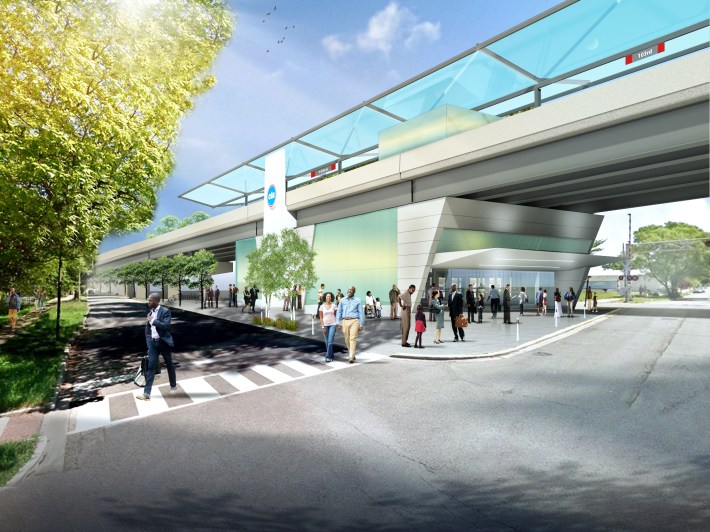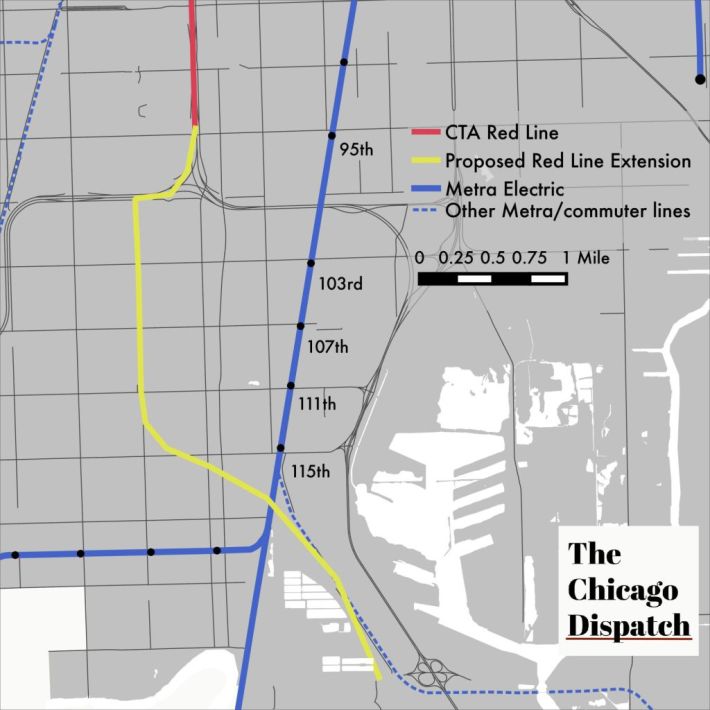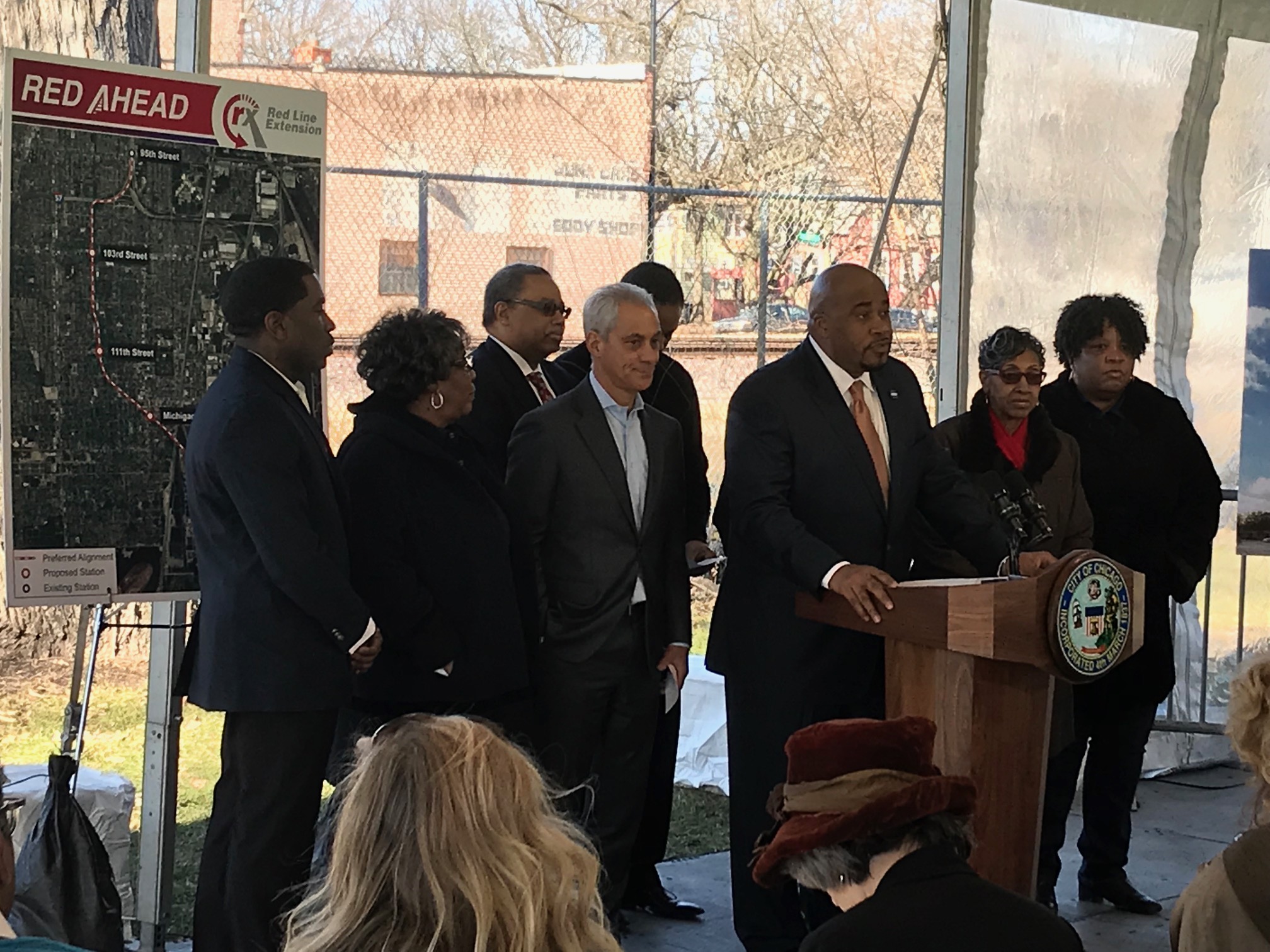This morning the city announced the intended route for the long-awaited south Red Line extension, which would lengthen the backbone of the ‘L’ system by another 5.3 miles, from the existing 95th Street terminal to 130th Street. However, questions remain about where the funding for the $2.3 billion project will come for, and whether it might make sense to pursue lower-cost alternatives.
The proposed extension would include four new stations near 103rd Street, 111th Street, Michigan Avenue and 130th Street. Each of the new stations would include bus facilities and car parking. Following technical analysis and a public input process, the CTA has chosen a route that would:
- Begin the extension at 95th Street and run along the west side of the Union Pacific Railroad tracks from I-57 south to about 109th Street;
- Cross the UPR tracks and run along the east side of the tracks until crossing the Metra Electric tracks near 119th Street; and
- Continue south to 130th Street.
The CTA also considered an alternative that would have involved elevated tracks on Halsted Street. However, this proposal faced opposition from residents and 9th Ward Alderman Anthony Beale, who argued that the tracks would hurt businesses on Halsted.
“Today we are taking a major step towards extending the Red Line to 130th Street and delivering the jobs and economic opportunities that go with it,” said Mayor Rahm Emanuel at this morning’s announcement at Block Park at 103rd Street and Harvard Avenue, near the proposed 103rd Street stop. “By extending the Red Line south we are strengthening Chicagoans’ connections to each other, to opportunity and to the world.”
Building the line will require purchasing some 150 properties. If any owners refuse to sell, the city could likely force their hands via the eminent domain process, but that could delay the project’s timeline. The train route also passes by several large unoccupied land parcels, which the city notes could become appealing to developers once the train stations open.

The CTA will produce a final Environmental Impact Study that will include preliminary engineering work and an analysis impacts of the proposed alignment. This engineering work is required before CTA can apply for more than $1 billion in federal funds for the project. The transit agency expects to apply to the Federal Transit Administration for entry into the project development phase of this project, a necessary step to pursue federal funding for the project under the competitive federal New Starts grant program.
However, the Donald Trump administration has previously announced its intention of eliminating the New Starts program, and all other federal funding for transit. Meanwhile, the city of Chicago and the state of Illinois face major budget problems.
In late 2016, City Council approved a special transit tax-increment financing district along the project area for the 2.1 billion first phase of the Red and Purple Modernization project, which will rehab stations and track infrastructure between Belmont Avenue and Howard Street. That TIF, which will capture value from property tax revenue increases associated with the improved transit access, is projected to raise $622 million, which allowed Chicago to leverage a $1.1 billion federal grant, awarded shortly before Barack Obama left office a year ago.

However, partly due to the much lower population density and lower property values of the Red Line extension project area, a similar approach probably wouldn’t work at this location. The Metropolitan Planning Council has estimated that, at best, an RLE transit TIF would raise only $200 million over the next 35 years.
The CTA previously considered bus rapid transit as a much cheaper way to improve access for the communities along the Red Line extension route. However, Far South Siders have noted that they’ve been waiting for ‘L’ access since the extension was first proposed during the Richard J. Daley Era, and that they deserve high-quality rapid transit train service just as much as their North Side counterparts.
Another alternative for providing that service at a fraction of the $2.3 billion would be to convert the Metra Electric District line, which parallels the RLE route, to rapid transit frequency, with the fare system integrated with the CTA. The Coalition for a Modern Metra Electric, a collaboration between transportation organizations and South Side community groups, as well as citizen advocate Mike Payne, are pushing for this approach.
However this would require cooperation from CTA and Metra, which have a generally competitive relationship. Regional planning organizations such as the Regional Transit Authority and the Chicago Metropolitan Agency for Planning have favored the Red Line extension plan over converting the MED to rapid transit. Apparently they believe that it will be easier to prize a federal grant out of the Trump administration than to get CTA and Metra to play nice.
Correction 1/27/18: This article previously misstated the MPC projection for a south Red Line transit TIF. I apologize for the error.




